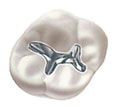Amalgam was first introduced in United States during 1833. It is then used widely as dental filling material over the years because of its strength, durability and low cost (especially for posterior teeth). It is now discontinued or banned in certain countries such as Norway, Sweden, Denmark because of its known biological effects on human body. Amalgam is made of metals such as Silver, Tin, Copper, Zinc and Mercury. 50% of amalgam is made of mercury and they are then mixed to form a hard material which has silvery grey appearance through a process which is known as amalgamation. Patients are exposed to high dose of mercury during the process of placing and removal of amalgam restoration.
What are the harmful effects of amalgam as dental filling material?
1. Central nervous system (consists of brain and spinal cord) is a part of our nervous system which receives information and coordinates activities. Absorption of mercury is fast and is taken up by the nerve axons to the brain and spinal cord. Studies have shown that mercury can cause mild behavioral to serious psychological problems such as depression, sleeping disturbances, parasthesias of certain body parts, Alzheimer (research by Dr Boyd Halers)and etc.
2. Mercury can also be passed from mother to fetus (through blood) and infants (through breast feeding).Although amount of mercury that has been transferred might be below level of toxicity, but there are some studies which proved that mercury exposure is a risk of developing autism in infants.
3. Some patients might develop allergic reactions such as rashes , lichenoid like lesions as a result of having amalgam dental fillings. Lichenoid lesions, which are similar to lesions seen on lichen planus patients, will normally disappear after the removal of amalgam restoration. It is rare to develop allergic reactions against amalgam but if it happens, please do not hesitate to inform your dental surgeon about it.
4. Prolonged exposure to amalgam can bring side effects to dental personnel. During the packing or removal of amalgam restoration, certain amount of mercury vapor can be released to the atmosphere. Spillage of amalgam during handling can also cause increase the concentration of mercury in the atmosphere. Thus, handling of excess amalgam material should be careful such as proper disposal of amalgam in chemical solution.
It is undeniable that amalgam is a strong and cheap restorative material. There are two schools of thoughts regarding amalgam toxicity. If you are given a choice between amalgam or other restorative materials to fill your teeth, please do not hesitate to consult your dental surgeon regarding the advantages and disadvantages of the available materials.
